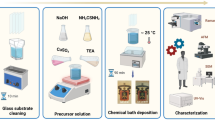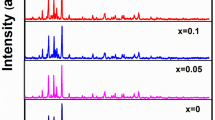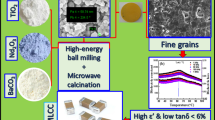Abstract
A new water-soluble precursor of BaTiO3 was prepared from citratoperoxotitanate and barium citrate as the Ti and Ba sources, respectively. The water-soluble precursor was easily solved in water to form a stable solution, which produced BaTiO3 by heat-treatment at 500 °C and above. A water-based dip-coating technique demonstrated a potential application as the coating solution of BaTiO3. Transparent BaTiO3 films were formed on the quartz-glass substrates with an increment of typically 9 nm per coating with 0.05 mol dm−3 solution. The transmittance of the 180 nm-thick film attained almost 90 % at the maximum and the overall transmittance was above 60 % over the visible region. The polycrystalline film was composed of BaTiO3 grains smaller than 200 nm. Although the film was an insulator, it was not suited for the dielectric application because of the structural problems due to the relatively low density and the thinness of the BaTiO3 layer. The BaTiO3 pellet obtained from the water soluble precursor by condensation, pyrolysis and sintering showed the good dielectric properties with εr = 3,500 and tan δ = 0.027 with a sintering temperature of 1,375 °C.









Similar content being viewed by others
References
Viviani M, Nanni P, Buscaglia MT, Leoni M, Buscaglia V, Centurioni L (1999) Impedance spectroscopy of n-doped (Ba, Sr)TiO3 ceramics prepared by modified low temperature aqueous synthesis. J Euro Ceram Soc 19:781–785
Castro MS, Salgueiro W, Somoza A (2007) Electron paramagnetic resonance and positron annihilation study of the compensation mechanisms in donor-doped BaTiO3 ceramis. J Phys Chem Solids 68:1315–1323
Vijatovic Petrovic MM, Bobic JD, Ramoska T, Banys J, Stojanovic BD (2011) Electrical properties of lanthanum doped barium titanate ceramics. Mater Charact 62:1000–1006
Haaijman PW, Dam RW, Klassens HA (1955) Method of preparation of semiconducting materials. German Pat No. 929 350
Chen YL, Yang SF (2011) PTCR effect in donor doped barium titanate: review of compositions, microstructures, processing and properties. Adv Appl Ceram 110:257–269
Tseng TY, Lu YY (1988) Processing and applications of lanthanum-doped Ba0.8Sr0.2TiO3 PTCR ceramics. Ceram Int 14:195–198
Nowotny J, Rekas M (1991) Positive temperature coefficient of resistivity for BaTiO3-based materials. Ceram Int 17:227–241
Yoon KH, Oh KY, Yoon SO (1986) Influence of synthesis methods of the PTCR effect in semiconductive BaTiO3. Mater Res Bull 21:1429–1437
Segal D (1989) Chemical synthesis of advanced ceramic materials. Cambridge University Press, Cambridge
Pierre AC (1998) Introduction to Sol-Gel Processing (The Kluwer International Series in Sol-Gel Processing). Kluwer, Boston
Kickelbick G (ed) (2007) Hybrid Materials. Wiley-VCH, Weinheim
Garcia Hernandez M, Carrillo Romo FJ, Garcia Murillo A, Jaramillo Vigueras D, Meneses Nava MA, Bartolo Perez P, Chadeyron G (2010) The influence of polyvinylpyrrolidone on thick and optical properties of BaTiO3:Er3+ thin films prepared by sol-gel method. J Sol-gel Sci Tech 53:246–254
Ashiri R, Nemati A, Ghamsari MS, Aadelkhani H (2009) Characterization of optical properties of amorphous BaTiO3 nanothin films. J Non-Cryst Solids 355:2480–2484
Mohammadi MR, Rad AE, Fray DJ (2009) Water-based sol-gel nanocrystalline barium titanate: controlling the crystal structure and phase transformation by Ba:Ti atomic ratio. J Mater Sci 44:4959–4968
Yang WD, Haile SM (2006) Characterization and microstructure of highly preferred oriented lead barium titanate thin films on MgO(100) by sol-gel process. Thin Solid Films 510:55–61
Kumazawa H, Masuda K (1999) Fabrication of barium titanate thin films with a high dielectric constant by a sol-gel technique. Thin Solid Films 353:144–148
Sakka S, Kokubo T (1983) Preparation of glasses and ceramics for electrical use based on alkoxide and unidirectional solidification methods. Jpn J Appl Phys Suppl 22–2:3–7
Manso-Silván M, Fuentes-Cobas L, Martín-Palma RJ, Hernández-Vélez M, Matínez-Duart JM (2002) BaTiO3 thin films obtained by sol-gel spin coating. Surf Coating Tech 151–152:118–121
Yang J, Zhang T, Ni M, Ding L, Zhang WF (2009) Structural and optical properties of Ba(Ti1-xNix)O3 thin films prepared by sol-gel process. Appl Surf Sci 256:17–20
Hosokura T, Ando A, Sakabe Y (2006) Fabrication and electrical characterization of epitaxially grown (Ba, Sr)TiO3 thin films prepared by sol-gel method. Electroceram Jpn IX (Key Eng Mater) 320:81–84
Kumar M, Roy SC, Bhatnagar MC, Agarwals S, Sharma GL (2005) Study of dielectric and pyroelectric properties of sol-gel derived BST thin films. Ferroelectrics 329:33–37
Yang X, Yao X, Zhang L (2004) Modified sol-gel processing for preparation of barium strontium titanate ceramic thin films. Ceram Int 30:1525–1527
Kozuka H, Takenaka S, Tokita H, Okubayashi M (2004) PVP-assisted sol-gel deposition of single layer ferroelectric thin films over submicron or micron in thickness. J Eur Ceram Soc 24:1585–1588
Wang C, Hu J, Chow GM (2005) Structural and optical properties of sol-gel-derived Au/BaTiO3 nanocomposite thin films. J Am Ceram Soc 88:758–767
Kumar V, Packiaselvam I, Sivanandan K, Vahab MA, Sinha AK (2006) Chemical solution deposition of (Ba1-xSrx)TiO3 thin films and characterization. J Am Ceram Soc 89:1136–1139
Venkata Saravanan K, Sudheendran K, Ghanashyam Krishna M, James Raju KC, Bhatnagar AK (2007) Structural, optical and microwave characteristics of sol-gel derived barium strontium titanate thin films. Mater Chem Phys 105:426–432
Kozuka H, Okamoto D, Nishikawa H, Doi K (2004) Novel sol-gel technique for preparing single-phase complex oxide thin films from aqueous solutions of metal salts. Trans Mater Res Soc Jpn 29:2239–2242
Zhang HX, Kam CH, Zhou Y, Han XQ, Lam YL, Chan YC, Pita K (2000) Optical and electrical properties of sol-gel derived BaTiO3 films on ITO coated glass. Mater Chem Phys 63:174–177
Kozuka H, Higuchi A (2003) Stabilization of poly(vinylpyrrolidone)-containing alkoxide solutions for thick sol-gel barium titanate films. J Am Ceram Soc 86:33–38
Hayashi T, Oji N, Maiwa H (1994) Film thickness dependence of dielectric properties of BaTiO3 thin films prepared by sol-gel method. Jpn J Appl Phys 33(Pt 1):5277–5280
Ohya Y, Ito T, Takahashi Y (1994) Dielectric properties of multilayered ferroelectric thin films fabricated by sol-gel method. Jpn J Appl Phys 33(Pt 1):5272–5276
Lee JK, Hong KS, Jang JW (2001) Roles of Ba/Ti ratios in the dielectric properties of BaTiO3 ceramics. J Am Ceram Soc 84:2001–2006
Lin TF, Hu CT, Lin IN (1990) Influence of stoichiometry on the microstructure and positive temperature coefficient of resistivity of semiconducting barium titanate ceramics. J Am Ceram Soc 73:531–536
Choi JS, Kim HG (1992) Influence of stoichiometry and impurity on the sintering behaviour of barium titanate ceramics. J Mater Sci 27:1285–1290
Kakihana M, Tada M, Shiro M, Petrykin V, Osada M, Nakamura Y (2001) Structure and stability of water soluble (NH4)8[Ti4(C6H4O7)4(O2)4]·8H2O. Inorg Chem 40:891–894
Wagata H, Gallage R, Yoshimura M, Matsushita N (2009) Patterning of BaTiO3 by inkjet deposition using a precursor solution. Mater Sci Eng B161:146–150
Tada M, Tomita K, Petrykin V, Kakihana M (2002) Preparation and characterization of citratoperoxotitanate barium compound for BaTiO3 synthesis. Solid State Ionics 151:293–297
Pechini MP (1967) Method of preparing lead and alkaline earth titanates and niobates and coating method using the same to form a capacitor. U.S. Pat No. 3 330 697
Xu J, Tsutai S, Hayashi S, Sugai M, Nakagawa Z (1999) Thermal decomposition process of barium titanyl oxalate tetrahydrate. J Ceram Soc Jpn 107:27–30
Kumar S, Messing GL, White WB (1993) Metal organic resin derived barium titanate: I, formation of barium titanium oxycarbonate intermediate. J Am Ceram Soc 76:617–624
Arima M, Kakihana M, Nakamura Y, Yashima M, Yoshimura M (1996) Polymerized complex route to barium titanate powders using barium-titanium mixed-metal citric acid complex. J Am Ceram Soc 79:2847–2856
Sakabe Y, Yamashita Y, Yamamoto H (2005) Dielectric properties of nano-crystalline BaTiO3 synthesized by micro-emulsion method. J Euro Ceram Soc 25:2739–2742
Thomas R, Dube DC, Kamalasanan MN, Chandra S (1999) Optical and electrical properties of BaTiO3 thin films prepared by chemical solution deposition. Thin Solid Films 346:212–225
Acknowledgments
This work was financially supported in part by Grant-in-aid for Young Scientists (B) 22760507 from The Ministry of Education, Culture, Sports, Science and Technology (MEXT) and Murata Science Foundation (2010).
Author information
Authors and Affiliations
Corresponding author
Rights and permissions
About this article
Cite this article
Iwase, K., Kasuga, S., Kawai, T. et al. A water-soluble precursor of BaTiO3 and transparent BaTiO3 thin-films prepared from the solution by a water-based dip-coating technique. J Sol-Gel Sci Technol 64, 170–177 (2012). https://doi.org/10.1007/s10971-012-2844-1
Received:
Accepted:
Published:
Issue Date:
DOI: https://doi.org/10.1007/s10971-012-2844-1




